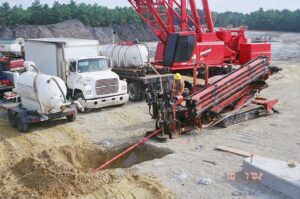Soil contamination often requires further intervention beyond a simple excavation to achieve remediation goals. Read on to learn more about why remediation of contaminated soil is important, why horizontal wells are frequently chosen for soil remediation, and how your contaminated site may benefit from evaluating horizontal soil remediation techniques.
How To Effectively Remediate Contaminated Soil
Contaminated soil remediation can be achieved through a variety of methods that can reduce or remove concentrations of hazardous substances found in the vadose zone of the subsurface. Common causes of soil contamination are commercial/industrial activities, leaking underground storage tanks, and surface spills. Depending on a variety of environmental factors and the types of contaminants involved, untreated soil contamination can lead to groundwater contamination, vapor intrusion into indoor spaces, and direct surface exposure pathways. Unlike groundwater contamination, there are some instances where shallow contaminated soil can simply be removed at the source from the surface. However, it is frequently impractical to excavate the entirety of a contaminated soil footprint. In situ remediation techniques used to remediate contaminated soil include soil vapor extraction, ISCO/ISCR injection, bioremediation, and thermal remediation. These techniques can be used to remove concentrations of hazardous substances or to control the migration of hazardous soil vapors.
What Are the Advantages of Using Horizontal Wells for Soil Contamination?

Vertical wells are the most common method to implement in-situ remediation techniques. However, various site limitations can make vertical wells challenging to implement effectively. Common site conditions that limit the efficacy of vertical wells include lack of access to the area above the contaminated soil due to infrastructure or sensitive areas, industrial, commercial, and residential uses of the property that cannot easily tolerate interruptions during remedial construction, and O&M, challenging geology, and future site redevelopment. Horizontal remediation wells are frequently utilized to overcome these site conditions and implement contaminated soil remediation techniques. Unlike conventional vertical remediation wells, horizontal remediation wells can access the contaminant soil from almost anywhere through the use of directional drilling techniques. Not only do horizontal remediation wells allow you to access the contamination, they are also far more effective at cleaning up contamination. A horizontal well screen allows significantly more contact with the contaminant plume, allowing for more efficient treatment of wider areas of the subsurface. They can also be precisely targeted to focus on problematic hot spots. The resulting radius of influence that can be achieved by horizontal remediation wells allows for enhanced remediation performance and less time to meet cleanup goals.
Horizontal remediation wells are an effective way to reduce various common types of soil contamination. Horizontal soil remediation techniques are proven to provide the most effective remediation performance by providing unparalleled access to contaminated areas of the subsurface. If you have a contaminated site that could benefit from horizontal remediation, please click HERE to tell us about your project so that we can help you determine whether horizontal remediation may be an effective solution to contaminated soil associated with your project.